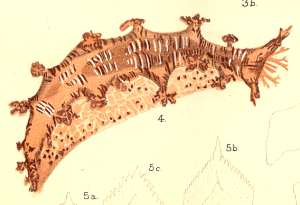
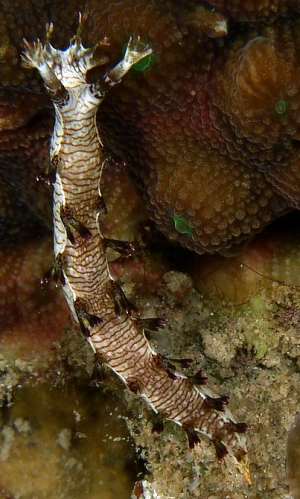
Marionia levis
Eliot, 1904
Order: NUDIBRANCHIA
Suborder: DENDRONOTINA
Family: Tritoniidae
DISTRIBUTION
western Indian Ocean [Comoro Ids, Tanzania, Kenya, Red Sea].
PHOTO
Upper: Eliot (1904), original illustration of Marionia levis. Plate 4, fig. 4. Lower: Eilat bay, Israel, Red Sea. Photographer: Oren Lederman
A narrow elongate tritoniid with up to 9 or to gills down each side of the mantle. The gilla are arranged in pairs, one on each side, the first pair exending out almost horizontally, the next pair stading vertically, and the rest in alternating position. The mantle edge is clearly delineated by a small ridge usually outline in white. The colour of the body ranges from grey to brown or green and there is a pattern of dark brown transverse lines across the mantle. There are sometimes white lines or rows of white dots as well. There is usually a similar colour pattern on the sides of the body. Dark brown spots are usually present on the gill stalks and the rhinophore sheaths. Avila, Kelman, Kashman & Benayahu (1999) report that this species feeds exclusively on the soft coral Parerythropodium fulvum fulvum, where it is often found. There are colour forms to match the variable colour of the soft coral on which they are found. This colour match, and their gills, which look remarkably like the extended polyps of the soft coral, make them extremely well camouflaged. It grows to about 40 mm long alive but is usually about half that size.
Originally described from East Africa, there are reports now on the Forum from much of the tropical western Indian Ocean. In a separate message [#13842] I discuss why Marioniopsis fulvicola Avila, Kelman, Kashman & Benayahu, 1999, described from Eilat, Red Sea is a synonym.
-
Avila, C., Kelman, D., Kashman, Y., and Benayahu, Y. (1999) An association between a dendronotid nudibranch (Mollusca, Opisthobranchia) and a soft coral (Octocorallia, Alcyonaria) from the Red Sea. Journal of Natural History 33: 1433-1449.
-
Eliot, C.N.E. (1904) On some nudibranchs from East Africa and Zanzibar. Part V. Proceedings of the Zoological Society of London, 1904(2): 83-105, Pls.3-4.
-
Yonow, N. (2000) Red Sea Opisthobranchia 4: The orders Cephalaspidea, Anaspidea, Notaspidea and Nudibranchia: Dendronotacea and Aeolidacea. Fauna of Arabia, 18: 87-131.
Rudman, W.B., 2005 (May 20) Marionia levis Eliot, 1904. [In] Sea Slug Forum. Australian Museum, Sydney. Available from http://www.seaslugforum.net/find/marilevi
Related messages
Marionia levis feeding
June 1, 2005
From: Binyamin Koretz
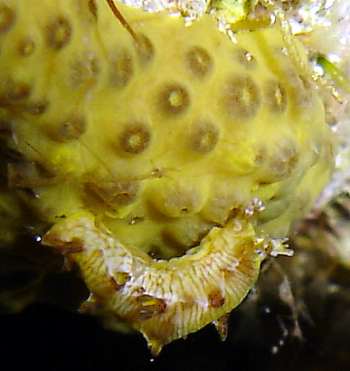
Hi Bill,
As you requested [message #13830], here is a photo of Marionia levis on its food coral - the soft coral formerly known as Parerythropodium fulvum.
Fabricius and Alderslade's book "Soft Corals and Sea Fans" (published in 2001 by AIMS) has a very similar picture on page 88 (and thanks to my friend Dr. Jacob Dafni for bringing that to my attention). According to the text, all species of Parerythropodium were reclassifed in Rhytisma (Alderslade, 2000).
Locality: Eilat, Lighthouse Beach, Israel. Red Sea (Gulf of Eilat). Depth: 9 m. Length: ca. 1 cm. 25 May 2005 (night). corals and rubble. Photographer: Binyamin and Shulamit Koretz
Best regards
Binyamin
binyamin@koretz.net
Koretz, B., 2005 (Jun 1) Marionia levis feeding. [Message in] Sea Slug Forum. Australian Museum, Sydney. Available from http://www.seaslugforum.net/find/13893Dear Binyamin,
Thanks for this - wouldn't life be wonderful if all requests were answered so dutifully! Is this a soft coral that has its polyps extended at night or during the day? Why I ask is that a specimen I was sent of this species some years ago had its gut packed full of polyps, each of which had been neatly cut off at the base of the stalk. This species apparently feeds only on extended polyps.
Best wishes,
Bill Rudman
Re: Marionia levis from Mombasa
May 24, 2005
From: Ilan Ben Tov
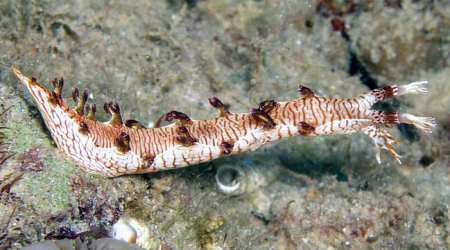
Dear Bill,
Concerning the message [#13785] about Marionia levis, here is one from Eilat, Israel, we get to see it from time to time.
Locality: Eilat, Israel. Red Sea. Depth: 27 m. Length: 5 cm. 2 May 2004. Photographer: Ilan Ben Tov
Regards,
Ilan Ben Tov
ilanbt@gilat.com
Ben Tov, I., 2005 (May 24) Re: Marionia levis from Mombasa. [Message in] Sea Slug Forum. Australian Museum, Sydney. Available from http://www.seaslugforum.net/find/13818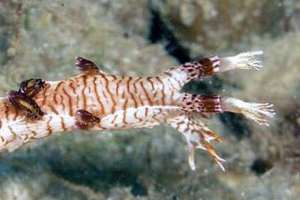
Thanks Ilan,
With the help of Forum partcipants, this species went from 'rare' to 'quite common' very quickly. The close-up of the head alongside shows most of the species' characteristics including the brown transverse lines on the body, the dark brown band on the rhinophores sheath (with brown spots below), and the unbranched, or seldom branched papillae on the oral veil. The first two pairs of gills in the photo show how the most anterior pair are held outwards, and the next pair stand upright - a sequence repeated down the body.
Best wishes,
Bill Rudman
Re: Marionia levis
May 20, 2005
From: Binyamin Koretz
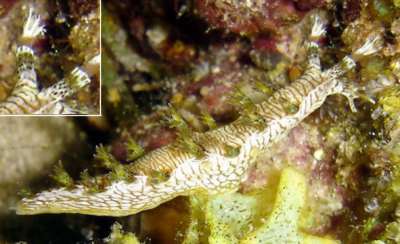
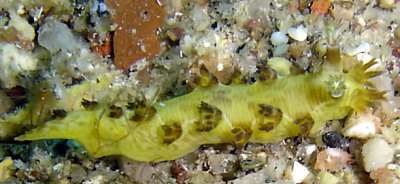
Dear Bill,
Concerning the message on Marionia levis from Mombasa [#13785]:
Tritoniid nudibranchs similar to this description are quite common in our area. If they are all Marionia levis, that will clear up a big question for a lot of us.
One complication I think worth mentioning is the degree of variation in color and pattern, which has led me to wonder whether we're seeing 1, 2 or 3 species, although the gills are similarly patterned among most of them, and there may be examples that can't be easily sorted out.
The most common variation is whitish with purple lines and a clear demarcation of the dorsum. Another fairly common type is quite greenish top and bottom, often with a cross-hatch pattern. The third type is quite reddish with white speckling, and with a bright white underside. I've attached one example from each type for illustration.
Locality: Eilat, Israel, Red Sea. all depths. Length: up to 3 cm. various dates. all types of locality. Photographer: Binyamin and Shulamit Koretz
Best regards
Binyamin
binyamin@koretz.net
Koretz, B., 2005 (May 20) Re: Marionia levis. [Message in] Sea Slug Forum. Australian Museum, Sydney. Available from http://www.seaslugforum.net/find/13830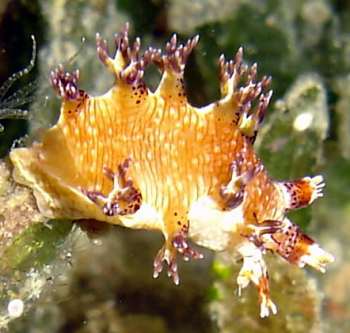
Dear Binyamin,
Thanks for this set of photos. We don't know very much about this species. I had begun to wonder whether the elongate body in most photos was different from the original painting in Eliot's description, but your photo alongside of an animal not fully extended looks very like the painting. I agree that your middle photo doesn't show the mantle edge very clearly but I can see a white line on the right side of the animal linking the rhinophores and gills which marks the mantle edge. Certainly the transverse brown, and in some cases whitish lines, across the mantle and sides of the body, and the dark brown spots on the gill stalks and rhinophores sheaths are consistent features of the colour pattern. And the gills arranged in alternating pairs the first held out horizontally then the next vertically, is also a consistent feature.
As I discuss in a separate message [#13842], this species was described from Eilat, as a new species, quite recently. It wouold be interesting to try and get some photos of it on its host soft coral.
Best wishes,
Bill Rudman
Re: Marionia levis from Mombasa
May 20, 2005
From: Marina Poddubetskaia
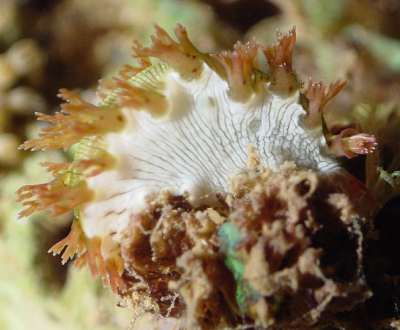
Dear Valérie and Bill,
When I saw your message [#13785] about Marionia levis, it reminded me of a lot about the animals I photographed in Mayotte, the Comoros, 2 years ago. Until now I considered them as unnamed species, but I would be happy to put a name on these guys. Bill, do you think they fit this species too ?
Locality: 'Bouzi', M'Sapéré, Mayotte Island, Comoro Ids, Indian Ocean.Depth: 10 m. Lengths: upper - 27-30mm; lower left - 29 mm; lower right - 27-30 mm. 12 November 2003. night dive. Photos: Marina Poddubetskaia
Best wishes,
Marina.
Nembro website
nembro@nembro.info
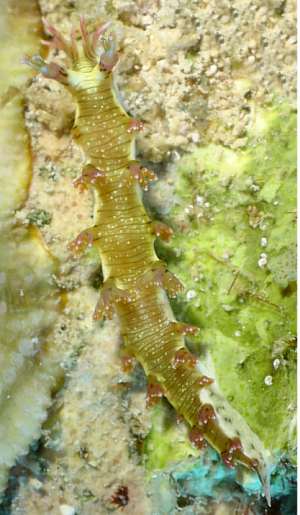
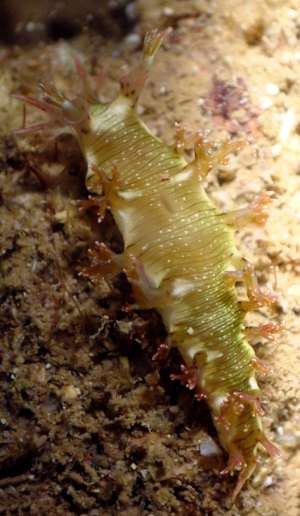
Dear Marina,
Thanks very much for these. I didn't think I would get such a quick response from you and others about this species. I am sure your animal is the same thing. There is a nomenclatural complication concerning this species which I was going to leave for a manuscript I have in preparation, but it seems silly not to mention it now I have so many photos to illustrate the colour variability in the species. Have a look at my separate message [#13842].
Best wishes,
Bill Rudman
Marionia levis and Marioniopsis fulvicola
May 20, 2005
From: Bill Rudman
I have been surprised by the almost immediate deluge of message concerning the tritoniid which I have identified as Marionia levis[#13785, #13832, #13830, #13809]. By coincidence, I have a manuscript in preparation discussing the identity of this species and was planning to leave the discussion of a nomenclatural problem until that was published, but now that the species has attracted such interest it seems silly not to discuss it here.
A new species of tritoniid, Marioniopsis fulvicola was recently described from the Red Sea (Avila, Kelman, Kashman & Benayahu, 1999). It was associated exclusively with the soft coral Parerythropodium fulvum fulvum on which it fed. Two colour morphs, yellow-brown and grey, were found, matching the colour forms of the soft coral on which they are found. This colour match, and their gills which look remarkably like the extended polyps of the soft coral, make them extremely well camouflaged. The external shape and colour of this species matches the photos on the Forum which I have identified as M. levis. One colour feature not mentioned by Avila et al, are dark brown spots found on the gills stalks and rhinophores of most specimens. However, Dr Benayahu, who found this species while studying the soft coral, had earlier sent me some preserved specimens, and in them the dark spots, deep red in alcohol, are clearly visible.
Eliot's description of M. levis, based on 6 specimens from Zanzibar and Wasin Ids, East Africa, also fits this species well:
'The living animals were high and narrow in shape, with a flat back. The sides were described as white, mottled with translucent patches. The ground colour of the back was a light purplish brown, with stripes of the same colour but darker and others of white. The branchiae and rhinophores were pink with dark red blotches.'
However there are some a major differences in the internal anatomy. For example the radular formula of M. levis is approx 47 x 80 + 1.1.1.+ 80 and M. fulvicola is 40 x 42 + 1.1.1 + 42. Another difference are the number of gizzard/stomach plates, approximately 30 in M. fulvicola and approx 150 in M. levis. The Benayahu specimens I have looked at match the anatomical description of Avila et. al. It would seem there are either two species, very similar externally, but quite different internally, or that Eliot's description of the internal anatomy is wrong.
My belief is that Eliot's description is incorrect. In his description he writes: 'An uninjured alcoholic specimen 26 mm long, 10 high, and 7 broad in the widest part, but one which was dissected was about twice as large.' As the largest live specimen recorded by Avila was 40 mm (26 mm preserved), I suspect the large specimen Eliot dissected (approx 52 mm long preserved) and from which I assume he obtained the radula and gizzard plates, was a different species. Although Eliot for a time lived in Zanazibar, his material came from a variety of collectors, and his knowledge of the living animals was often from notes made by the collectors. Eliot was describing seven similar species in this paper, and it is quite possible that either he or one of the collectors mixed two species together.
If this is so, which part of Eliot's description should we follow - the external description or the anatomical description? In practical terms, the anatomical description is not sufficient to identify the species - for that matter very few species can be identified solely from a description of their internal anatomy. That is why we have so much difficulty in identifying many species described by Rudolph Bergh, and more recently, Eveline & Ernst Marcus, which were based solely on preserved decolourised animals. We could look for type material and choose one specimen to designate as a lectotype, but since the specimens, if they exist, will be preserved and decolourised, we still won't know which represent the colour pattern in his illustration. The only sensible solution is to accept the colour illustration as representing the species and to treat the anatomical information as problematic.
For those reasons I consider Marioniopsis fulvicola to be a synonym of Marionia levis. Avila et al. provide us with valuable information on the natural history of this species, with about 25% of the colonies of the soft coral food, Parerythropodium fulvum fulvum, at the study site being occupied by at least one animal. Becaue they are so cryptic, specimens were often only discovered after the soft coral colony was touched, which caused the polyps to retract, and so the slug to be exposed. This animal also appears to sequester secondary metabolites from the soft coral in their tissues, presumably for defence.
-
Avila, C., Kelman, D., Kashman, Y., and Benayahu, Y. (1999) An association between a dendronotid nudibranch (Mollusca, Opisthobranchia) and a soft coral (Octocorallia, Alcyonaria) from the Red Sea. Journal of Natural History 33: 1433-1449.
-
Eliot, C.N.E. (1904) On some nudibranchs from East Africa and Zanzibar. Part V. Proceedings of the Zoological Society of London, 1904(2): 83-105, Pls.3-4.
-
Yonow, N. (2000) Red Sea Opisthobranchia 4: The orders Cephalaspidea, Anaspidea, Notaspidea and Nudibranchia: Dendronotacea and Aeolidacea. Fauna of Arabia, 18: 87-131.
Re: Marionia levis from Mombasa
May 20, 2005
From: Oren Lederman

Hi Bill,
Concerning the message on Marionia levis from Mombasa [#13785] :
I attached a photo of what I believe to be a Marionia levis from the Red Sea. I'm not sure though. These nudis are very common around here lately.
I stopped taking photos of this species months ago, so I don't remember the exact place, date, and depth for this one. sorry.
Locality: Eilat bay, Israel, Red Sea. Photographer: Oren Lederman
Oren Lederman
lederman@bigmail.co.il
Lederman, O., 2005 (May 20) Re: Marionia levis from Mombasa. [Message in] Sea Slug Forum. Australian Museum, Sydney. Available from http://www.seaslugforum.net/find/13809Dear Oren,
Thanks for this record. From it and the other messages I am posting today you can see it is quite variable in colour, but there are always transverse brown lines across the back and often dark brown specks on the gill stalks. Some appear to be narrower than others, but I assume that it a question of what position they are in when photographed.
Best wishes,
Bill Rudman
Marionia levis from Mombasa
May 17, 2005
From: Valérie Besnard
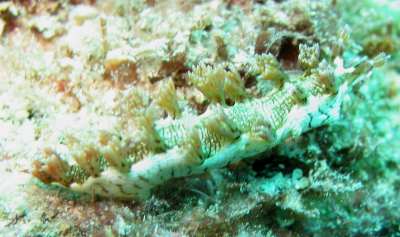
Dear Bill,
During a stay in Kenya (March 2005), I've saw this sea slug that I couldn't identify: Is it a tritonidae ???
Diani, Mombasa south, Kenya, 14 March 2005, size 5 cm, depth 15m, coral reef. Photo: Valérie Besnard
Thank you very much for your help !
Best regards,
Valérie
billr@seaslugforum.net
Besnard, V., 2005 (May 17) Marionia levis from Mombasa. [Message in] Sea Slug Forum. Australian Museum, Sydney. Available from http://www.seaslugforum.net/find/13785
Dear Valérie,
This is Marionia levis. Nathalie Yonow (2000) reported on an animal from the Red Sea but apart from that little is known of it. It was originally described from Est Africa.
Best wishes,
Bill Rudman
